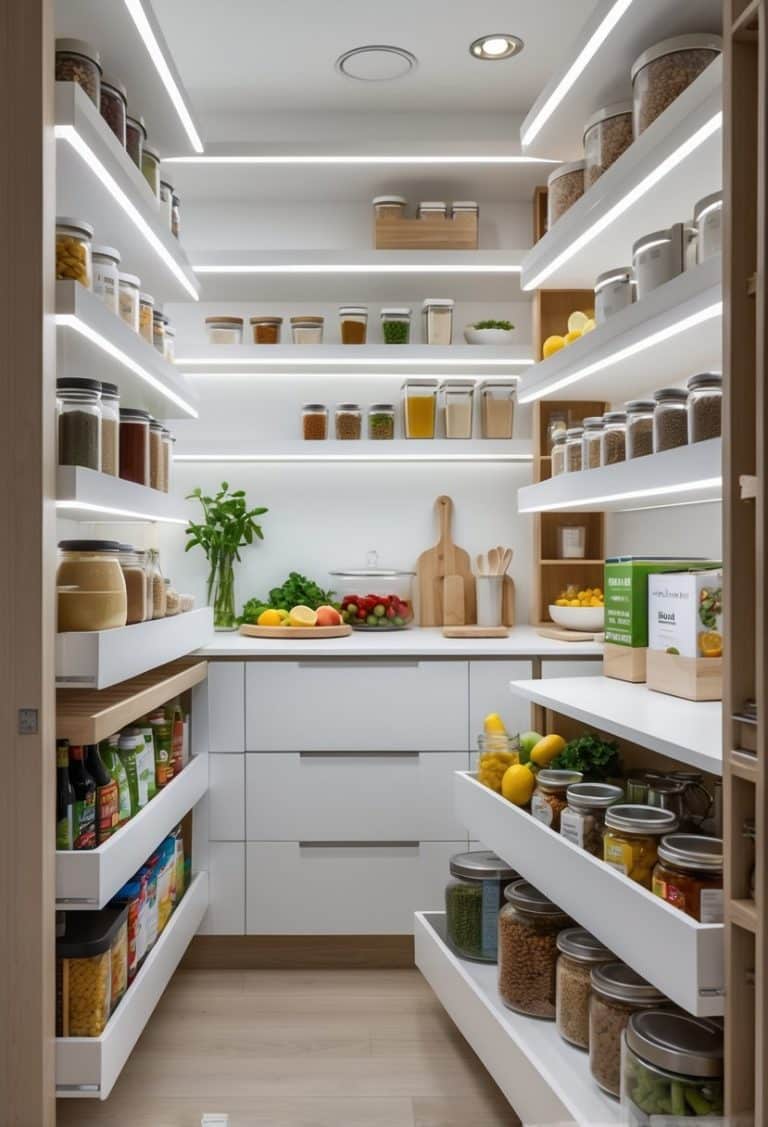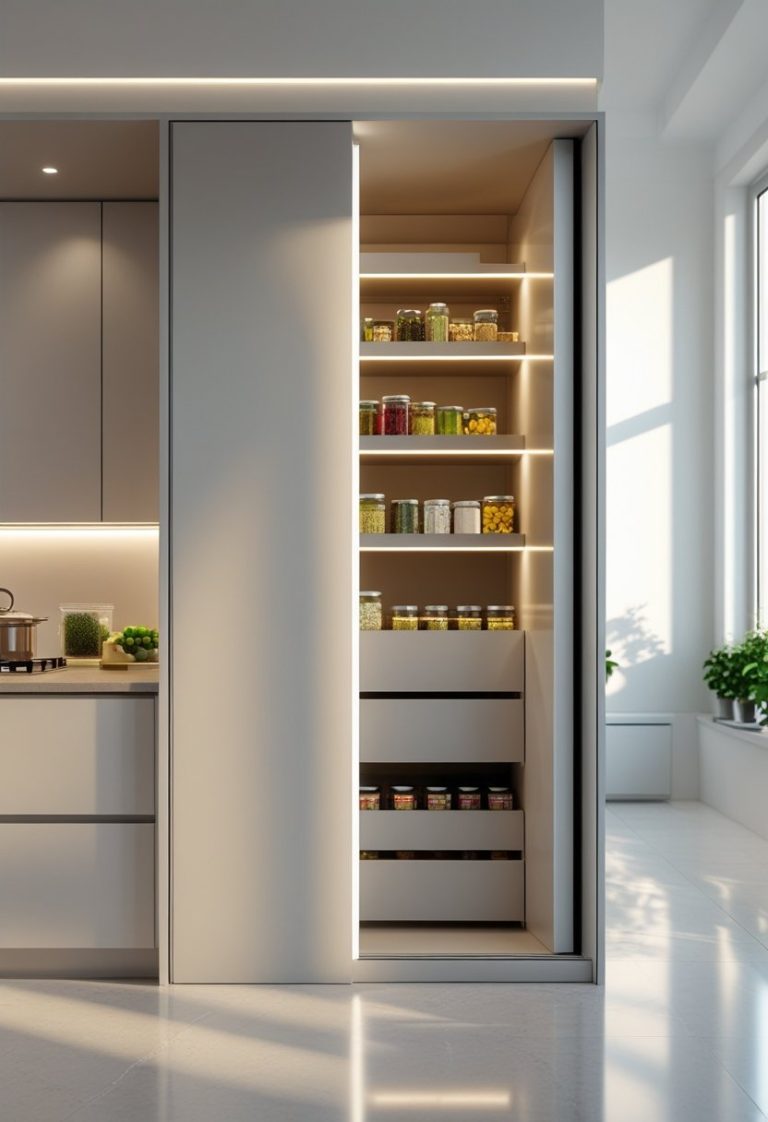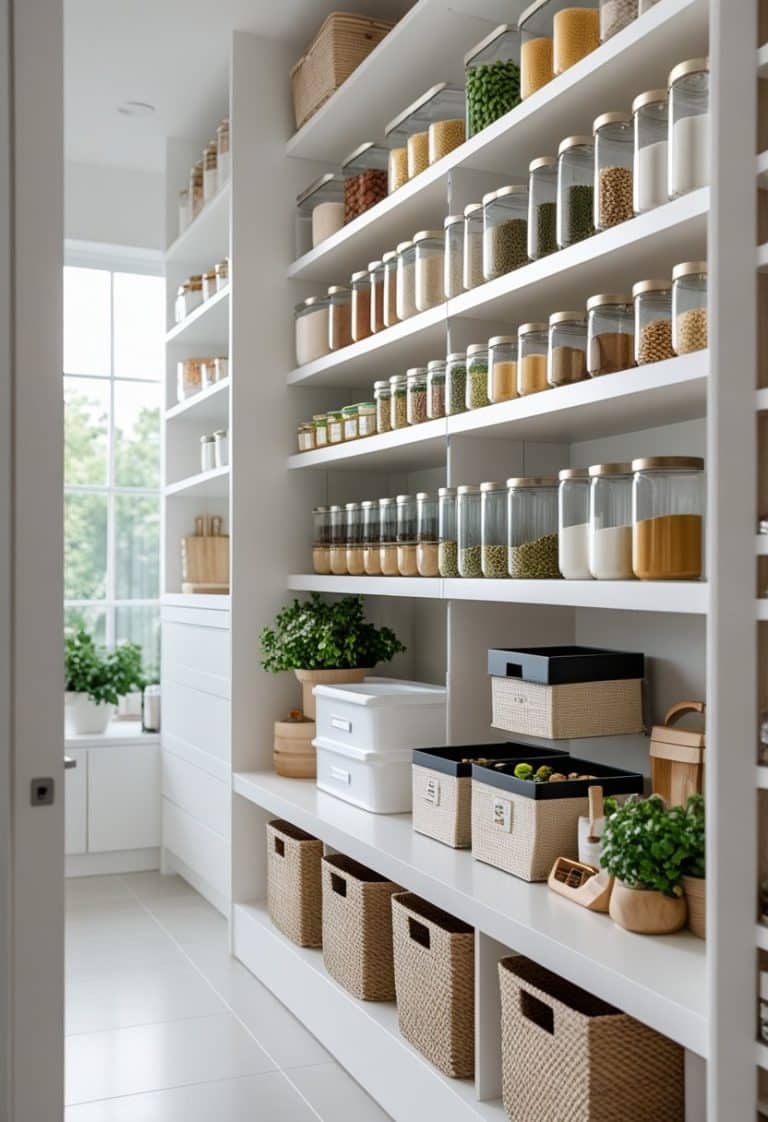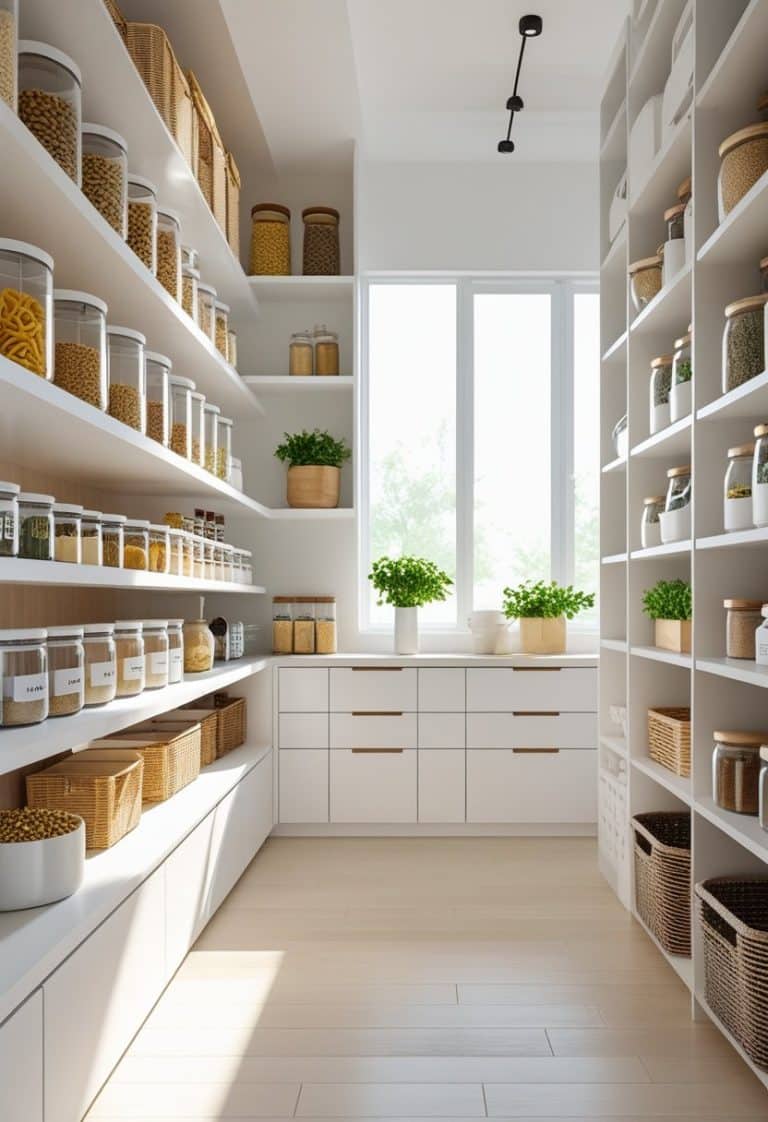Walk-In Pantry Ideas 2026: 22 Smart Designs for Modern Kitchen Storage
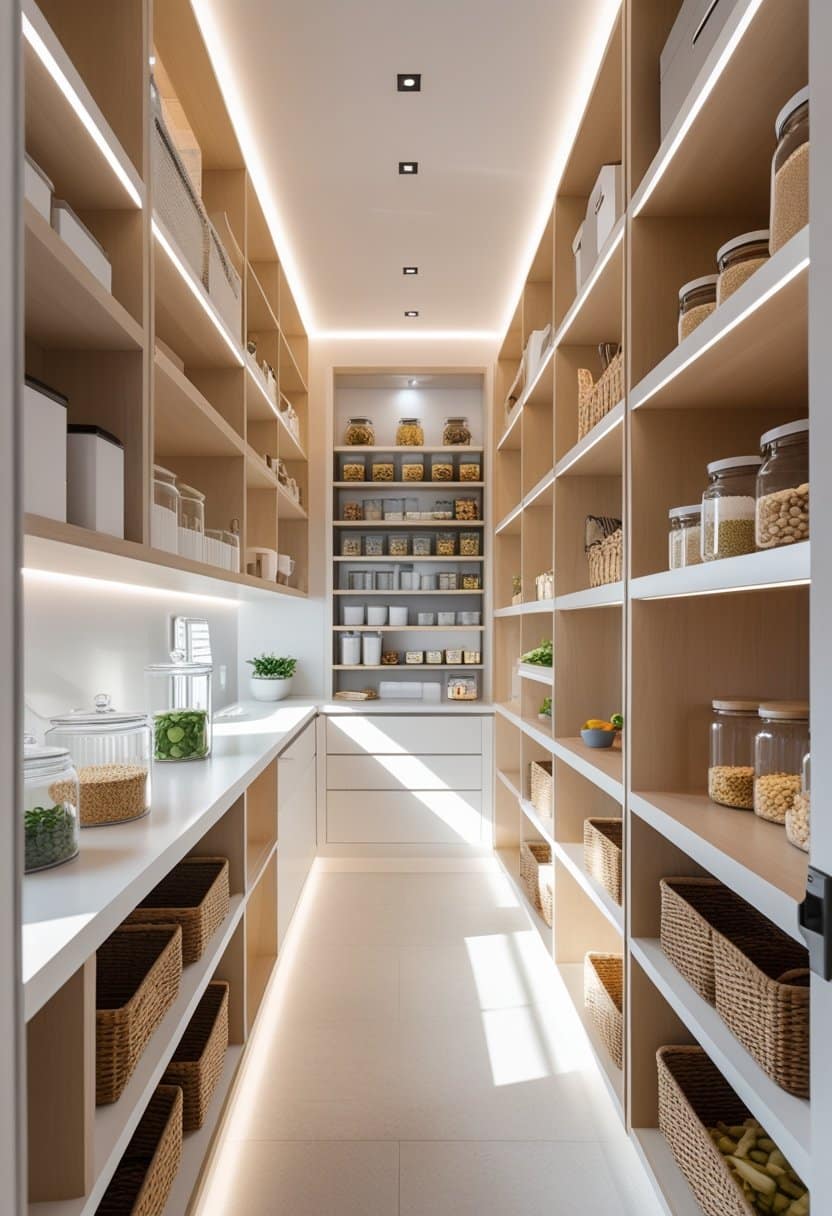
A walk-in pantry has become an essential feature in modern kitchens, offering both style and function. As home design trends evolve, pantries now serve as organized extensions of the kitchen rather than simple storage spaces. A well-designed walk-in pantry in 2026 helps create a cleaner, more efficient, and visually balanced kitchen environment.

This article explores practical ways to enhance pantry design through smart organization, lighting, and layout choices. It focuses on ideas that improve accessibility, maximize space, and add subtle elegance to everyday use. Each section highlights simple updates that make a noticeable difference in how a kitchen looks and functions.
Install adjustable shelving for flexible storage

Adjustable shelving lets homeowners change shelf heights to fit items of different sizes.
They can lower a shelf for tall cereal boxes or raise it for small jars and cans.
This flexibility helps maximize every inch of space and keeps the pantry organized without needing new shelving units.
Use clear, labeled containers for easy identification

Clear containers help people see contents quickly without opening each one. This makes it easier to track supplies and reduce waste.
Labels add another layer of order by naming what’s inside and where it belongs. Consistent labeling keeps the pantry tidy and simplifies restocking.
Incorporate pull-out drawers for accessibility

Pull-out drawers make pantry storage easier to reach and organize. They let users see items at a glance without bending or stretching.
These drawers work well for storing canned goods, snacks, and small appliances. Their smooth sliding design supports efficient use of space and keeps the pantry neat.
Add a built-in countertop for meal prep

A built-in countertop inside a walk-in pantry gives extra workspace for preparing meals or organizing groceries.
It keeps the main kitchen counters clear while offering a convenient spot for small appliances or chopping ingredients.
Homeowners often choose durable materials like quartz or laminate for easy cleaning and long-lasting use.
Include open shelving for frequently used items

Open shelving keeps everyday ingredients and tools within easy reach. It helps reduce clutter by displaying only what is used most often.
They can group items by type, such as dry goods, spices, or baking supplies. Using uniform jars or bins keeps the space tidy and easy to maintain.
Use sliding barn doors to save space

Sliding barn doors help reduce clutter by removing the need for door swing clearance.
They glide along the wall, making them useful in small or narrow kitchens.
Their simple track system allows easy access to pantry shelves while maintaining a clean, functional look.
Install LED strip lighting for visibility

LED strip lighting helps brighten dark pantry shelves and corners. It provides even light that makes stored items easier to see.
They can attach strips under shelves or along walls for balanced illumination. Motion sensors or automatic switches can make the lighting more efficient and convenient.
Incorporate a small fridge for perishables

A compact fridge keeps milk, produce, and condiments within easy reach. It helps reduce trips to the main kitchen refrigerator.
Placing the fridge under a countertop or in a corner saves space. Proper ventilation and power access ensure it runs efficiently and stays convenient for daily use.
Use wire baskets for produce storage

Wire baskets help keep produce visible and easy to reach.
They allow air to circulate, which can extend the freshness of fruits and vegetables.
Homeowners can mount baskets on pantry walls or place them on lower shelves.
This setup saves counter space and keeps everyday items neatly organized.
Add a chalkboard wall for grocery lists

A chalkboard wall helps keep grocery lists and meal plans visible and organized.
Homeowners can use chalkboard paint or peel-and-stick decals to create a writable surface inside the pantry.
This feature makes it simple to note items to restock or plan weekly meals without using paper.
Include hooks for hanging utensils and aprons

Hooks make smart use of vertical space in a walk-in pantry.
They can hold aprons, measuring cups, or reusable bags, keeping shelves clear for food storage.
Mounting them on doors or blank walls helps organize small tools and keeps frequently used items within easy reach.
Use tiered spice racks for organization

Tiered spice racks help keep jars visible and easy to reach. They fit well on pantry shelves or inside cabinet doors.
By arranging spices in rows, people can quickly find what they need without moving other containers. This setup keeps the pantry neat and saves shelf space.
Incorporate a step stool stored within the pantry

A compact step stool helps reach high shelves safely and easily. It supports efficient use of vertical space without wasting storage potential.
They can store the stool in a narrow gap or hang it on a wall hook to keep the floor clear and the pantry organized.
Add a wine rack for beverage storage

A built-in wine rack helps organize bottles and saves counter space. It keeps wine within easy reach while maintaining a clean look.
They can mount racks on walls, fit them under shelves, or include them in cabinetry. This design works well for both small and large pantries.
Use deep shelves for bulk items

Deep shelves help store large or bulk items like cereal boxes, paper towels, and extra pantry staples.
They make good use of wall space and reduce clutter on countertops.
Clear bins or labeled containers keep items visible, so nothing gets lost in the back.
Include a designated snack drawer

A snack drawer keeps quick bites organized and easy to reach. It helps reduce clutter on shelves and counters.
They can use shallow drawers with dividers to separate items like granola bars, chips, or fruit packs. This setup makes restocking simple and keeps snacks visible for all ages.
Install a pegboard for customizable storage

A pegboard helps keep pantry tools and containers visible and easy to reach.
They can mount a metal or wooden board on one wall and use hooks, baskets, or shelves to hold utensils, small appliances, or cleaning supplies.
This setup adapts easily when storage needs change.
Use clear bins for baking supplies

Clear bins help keep baking ingredients visible and easy to find. They allow quick checks of what needs restocking without opening containers.
Grouping items like flour, sugar, and baking powder in labeled bins keeps the pantry tidy and reduces clutter. This method also helps maintain freshness and organization.
Add a pull-out trash and recycling center

A pull-out trash and recycling center helps keep a walk-in pantry clean and organized. It hides waste bins behind a cabinet door and frees up floor space.
Many models use soft-close slides for smooth movement and easy access. Dual bins make sorting trash and recyclables simple and efficient.
Include a built-in bread box

A built-in bread box keeps countertops clear and bread fresh longer. It fits neatly into pantry shelving or under a counter.
They can choose wood, metal, or glass doors to match the pantry’s style. This feature adds both function and a clean, organized appearance to the space.
Use decorative baskets for aesthetics and function

Decorative baskets add texture and warmth to a walk-in pantry while keeping items organized.
They work well for grouping snacks, linens, or small kitchen tools.
Woven or wire baskets help maintain a clean look and make it easy to find and access everyday essentials.
Install a lazy Susan for corner spaces

A lazy Susan helps use corner areas that often go to waste. It rotates smoothly, making stored items easier to reach.
Homeowners can choose wood, metal, or plastic designs to match their pantry style. Installation usually involves attaching rotating trays inside corner shelves for better access and organization.
Design Principles for Modern Walk-In Pantries

Modern walk-in pantries emphasize efficient use of space, clean design lines, and easy accessibility. They combine functional layouts with storage systems that keep food, appliances, and cookware organized while maintaining a cohesive kitchen style.
Optimizing Pantry Layouts
A well-planned layout helps users move easily and find items quickly. The design often depends on the pantry’s size and shape, such as L-shaped, U-shaped, or galley-style configurations. Each layout maximizes shelving and counter space while keeping pathways clear.
Designers recommend placing frequently used items at eye level and heavier goods on lower shelves. Adjustable shelving allows flexibility for tall containers or small appliances. In larger pantries, adding a small countertop provides space for meal prep or small appliances like mixers.
Lighting plays a key role. Bright LED strips or recessed lights improve visibility and make the space feel larger. For homes with windows, natural light reduces the need for artificial lighting during the day. Sliding or pocket doors can save space and maintain a seamless kitchen appearance.
Incorporating Smart Storage Solutions
Smart storage keeps the pantry organized and efficient. Features like pull-out drawers, tiered racks, and corner shelving help use every inch of space. Transparent bins or labeled containers make it easy to see contents and reduce waste from forgotten items.
Homeowners often include built-in sections for appliances such as mini-fridges, microwaves, or coffee makers. This keeps countertops clear and maintains a tidy look. Vertical storage, like tall shelving or hanging baskets, works well in narrow spaces.
A simple table below shows common storage features and their benefits:
| Feature | Benefit |
|---|---|
| Pull-out drawers | Easy access to deep shelves |
| Adjustable shelves | Fits items of different sizes |
| Clear bins | Quick visibility of contents |
| Hidden cabinets | Keeps clutter out of sight |
Enhancing Functionality and Aesthetics

Modern walk-in pantries in 2026 focus on efficient use of space and cohesive design. Homeowners value layouts that simplify food storage while maintaining a clean, stylish look that matches the rest of the kitchen.
Lighting and Accessibility Upgrades
Proper lighting improves visibility and ease of use. LED strip lights under shelves and recessed ceiling fixtures provide even illumination without glare. Motion sensors turn lights on automatically when someone enters, saving energy and adding convenience.
Designers often include task lighting near prep counters or small appliances. Adjustable brightness helps users see labels clearly and locate items quickly.
Accessibility features make the pantry more functional. Pull-out drawers, open shelving, and sliding baskets reduce bending or reaching. Wider walkways and pocket doors allow smoother movement in smaller layouts.
Smart systems are becoming common. Some pantries use lighting linked to smart home apps, letting users adjust brightness or color temperature from a phone or voice assistant.
Material and Color Trends for 2026
In 2026, materials emphasize durability and a clean finish. Laminate and engineered wood remain popular for shelving because they resist moisture and wear. Matte black hardware and brushed metal accents give a modern, simple look.
Natural textures such as oak, birch, and bamboo add warmth without clutter. Many designers pair these with light quartz or composite countertops for easy cleaning.
Color palettes lean toward soft neutrals like beige, light gray, and cream. Subtle pastel tones—such as blush pink or pale peach—add gentle contrast.
A mix of open and closed storage keeps the space organized and visually balanced. Frosted glass cabinet doors or mesh inserts let users see contents while maintaining a clean appearance.

